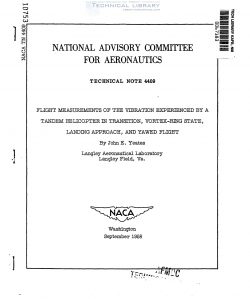naca-tn-4409
- Version
- 59 Downloads
- 835.56 KB File Size
- 1 File Count
- April 15, 2017 Create Date
- April 15, 2017 Last Updated
Flight Measurements of the Vibration Experienced by a Tandem Helicopter in Transition

As part of a general program of helicopter vibration research, a
flight investigation involving several flight maneuvers that are critical
with respect to vibration has been conducted. The maneuvers include
transition near the ground, landing approaches, vortex—ring state, and
yawed forward flight.
For the transition region the peak vibration occurs in the forward— _
speed range where the interference induced flow is expected to be rapidly
changing and might be expected to influence vibration. The vibration
measured in the vortex-ring state is characterized by a large irregular
pulsing of the vibration envelope at a random frequency, which prdbably
indicates shedding of the vortices. The vibration experienced during a
landing approach can be markedly reduced by choosing a rotor speed which
minimizes the coupling of the structural components. In forward flight
at 40 knots the vibration is reduced by a factor of about 3 at the rear
rotor and is only slightly reduced at the front rotor when the helicopter
is yawed to an angle of about 25°.
The magnitude of the vibrations in some of the larger helicopters
has made these machines unacceptable for commercial or military opera-
tions. With some of the helicopters in current use, the vibrations are
tolerated but are very objectionable to the pilot and passengers. These
vibrations also affect flight safety, particularly from a structural
fatigue standpoint, as well as inducing pilot and passenger fatigue and
discomfort.
During the flight program of reference I, large-magnitude vibra—
tions were noted in flight conditions involving transition, vortex-ring
state, and landing approaches. The nearness of the rotor rotational
frequency to the uncoupled fuselage resonant frequency results in the
large amount of 5-per—revolution vibration (designated herein as 5—P)
present in flight. Because these vibrations are of considerable impbr—
tance from a structural and pilot fatigue standpoint, they were the sub-
ject of.further study, the results of which are reported herein.
| File | Action |
|---|---|
| naca-tn-4409 Flight Measurements of the Vibration Experienced by a Tandem Helicopter in Transition,.pdf | Download |

Comment On This Post